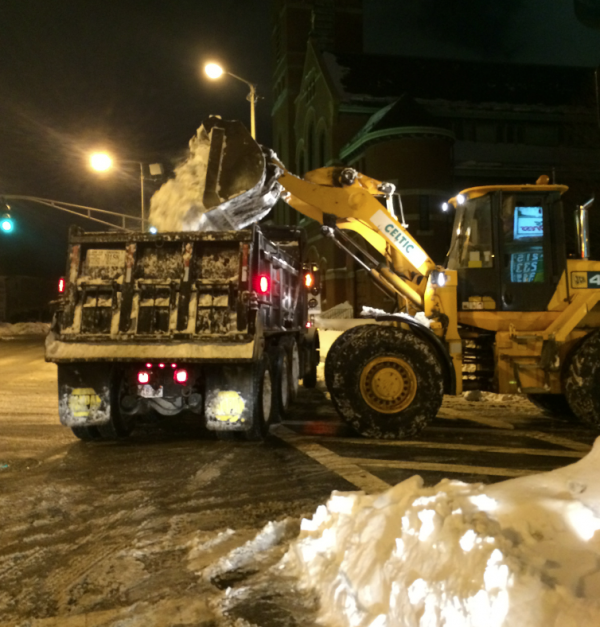February 11, 2015

Clearing snowbanks on Dorchester Avenue on Tuesday morning. Photo courtesy City of Boston
“How are you doing?” asked Department of Public Works supervisor Daniel Nee to a woman shoveling on Rock Terrace early Tuesday afternoon.
“Miserable!” she shouted back. “I’ve been shoveling all day. It’s such a small street. But I just retired so I’ve got plenty of time.”
The short and narrow one-way street in Bowdoin-Geneva was flagged to public works and a backhoe had just arrived, scooping snow and piling it against trees along the side of the street. The heavy equipment made quick work of the once-clogged street, and was soon off to treat another pocket of the neighborhood.
Nee, driving through Dorchester to survey the department’s work, was pleased. “If this street is our biggest problem, and it stopped snowing at 6 a.m., this is a job well done,” he said. Dorchester is one of the toughest neighborhoods in the city to plow–a maze of winding roads with lots of dead-ends mean more room for error for overworked cleaning crews.
The Saturday to Tuesday storm dumped another 23.1 inches of snow on the already stressed city of Boston, shutting down schools, businesses, roads, and trains as crews attempted to clean up. For much of the city of Boston, that falls on the Department of Public Works, whose crews have worked 16 hour shifts for the last two weeks to keep up with the historic 77.3 inches of snow.
With every storm, public works has tried to roll with the punches, first prepping the city’s 850 miles of roadway before the storms, plowing as the snow falls, and then heavy-duty removal once the snow stops, making sure streets are cleared from curb to curb and responding to requests streaming in from the Mayor’s Hotline and the Citizens Connect app.
During the most recent snow storm, it was easier for plows to keep up thanks to snowfall rates around one inch per hour. “When you reach two inches an hour, you fall behind,” Nee said. “Then it’s all downhill from there. In the very least, we’re just trying to keep streets passable for emergency vehicles and garbage trucks.”
Nee, who has worked for the department since 2002, said the city learned from last week’s mangled Wednesday morning commute. “That second storm killed us on Dot Ave. We already had big banks from the first snowstorm and this storm we were trying to push the snow over the banks and we just couldn’t do it. We weren’t as curb-to-curb as we could have been.”
Crews spent a considerable amount of time widening any snow-filled roadways with large front loaders, which can roll snow snow onto piles better than the plows’ blades that can only push snow up two or three feet–no help when most snow banks are higher than five feet.
On Tuesday afternoon, the city sent most of its drivers home for much needed sleep to prepare for their next trip out after the sun goes down. “You can really only do effective snow removal after 10 p.m. because everyone else is off of the streets,” Nee said. The snow melters are a huge help too, he said, clearing up vital space at 450 tons of snow per hour in the city’s snow farms.
Tuesday night into Wednesday, it is all about clearing out bus stops and schools, major pinch points for traffic, and knocking down the mounds of snow at intersections, Nee said.
Boston’s public school students returned to school on Wednesday, allowing them three days of class time ahead of next week’s scheduled February vacation. Mayor Martin Walsh announced school would also be held on March 17, June 17, and until June 30, with one extra class day built in to accommodate another canceled class day.
Walsh said he had been assured the MBTA would be able to transport students safely and efficiently to and from school on Wednesday, the day after the transit system shut down service on all major lines to clean up from the storm. It is not clear when the Mattapan Trolley line, which has been replaced by shuttle busses for the last two weeks and again on Wednesday, will be back on-line.
On Wednesday, crews also began to tackle the potholes cropping up on the city’s roads and collecting trash from overflowing barrels. “It’s a public safety concern,” Nee said.
All-told, the city has nearly doubled its $18 million snow removal budget for this (still not finished) winter season, Walsh said Tuesday, estimating $30 million will be doled out to cover the city’s overtime, fuel consumption, repairs, and truck maintenance. Nee said the city’s move over the last couple years to reinvest surplus funds back into new equipment has been a “lifesaver” this winter.
After nearly three weeks of storms and more on the horizon, “People are just tired,” Nee said. His shift wrapped up at 3:30 p.m., letting him head home to his wife, three young children, and a newly leaking roof from a neighbor’s ice dam. “It’s a lot. You don’t see your family. But I was able to eat waffles with my kids this morning.”
“But,” Nee added with a laugh, “I seriously do not know what day it is.”


